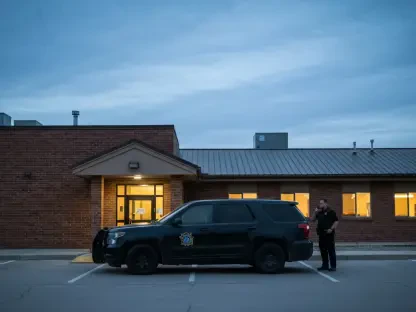In the heart of America’s urban centers, a battle over public safety rages on, with President Donald Trump at the forefront, sounding alarms over what he describes as an unprecedented crime wave sweeping the nation, while his dramatic interventions, such as deploying the National Guard to Washington, D.C., paint a picture of a country under siege, demanding swift and decisive action. Yet, beneath this bold narrative lies a stark contradiction: while Trump champions a tough-on-crime agenda, his administration has slashed funding for community-based violence prevention programs that have quietly transformed cities long plagued by violence. This profile delves into Trump’s crime rhetoric, exploring the policies, the data, and the grassroots efforts caught in the crossfire of federal decisions, revealing a complex figure whose approach to public safety sparks both fervent support and sharp criticism.
Unpacking Trump’s Crime Narrative
President Trump’s recent assertions about a rampant crime surge have captured national attention, positioning him as a staunch defender of law and order. His decision to deploy federal forces, including the National Guard, to Washington, D.C., underscores a belief that local authorities are failing to contain what he portrays as spiraling chaos. Public statements often highlight specific incidents of violence, amplifying a sense of urgency that resonates with segments of the population anxious about safety in their communities.
However, this narrative clashes with statistical realities that challenge the notion of a widespread crime epidemic. National data indicates a consistent decline in violent crime and murder rates over recent years, a trend that persists into the current landscape. Critics argue that Trump’s focus on isolated spikes distorts the broader picture, raising questions about whether political motives underpin these high-profile interventions rather than empirical evidence of a crisis.
The controversy deepens with the administration’s simultaneous cuts to prevention programs, a policy move that seems at odds with the stated goal of reducing crime. By prioritizing enforcement over proactive solutions, Trump has ignited a debate about the effectiveness of his strategy, particularly as cities reliant on community initiatives face operational setbacks. This tension between rhetoric and policy forms the crux of understanding his impact on public safety.
Contextualizing Crime Trends and Policy Shifts
To grasp the full scope of Trump’s crime stance, it’s essential to examine the backdrop of national crime trends. Contrary to claims of escalating danger, statistics reveal that murder and violent crime rates have been on a downward trajectory for several years. This decline, sustained through consistent local efforts, suggests that many American cities are safer now than in previous decades, challenging the urgency behind federal overreach.
Historically, public safety strategies have evolved from purely punitive measures to include community-based violence prevention, notably through Community Violence Intervention (CVI) programs. These initiatives, gaining traction over the past decade, focus on addressing root causes like poverty and trauma, offering alternatives to incarceration through mentorship and support services. Their rise marked a shift toward sustainable, localized solutions tailored to specific neighborhood needs.
Under Trump’s administration, however, funding for these CVI programs has faced significant reductions, reflecting a policy pivot back to enforcement-heavy approaches. This rollback, enacted through substantial budget cuts by the Justice Department, has left many programs struggling to maintain their reach, casting doubt on the long-term viability of prevention as a core component of crime policy. The divergence between data-driven progress and federal priorities highlights a critical rift in how safety is pursued.
Impact of Funding Cuts on Violence Prevention
The Trump administration’s decision to slash nearly $170 million in grants for CVI programs has sent shockwaves through cities dependent on these initiatives for violence reduction. Major urban areas like Detroit and Baltimore, which had seen remarkable gains through such efforts, now grapple with diminished resources. The Justice Department’s abrupt termination of funding has forced organizations to scale back operations, threatening to unravel years of hard-won progress.
These cuts translate into tangible losses on the ground, with programs facing staff reductions, halted client referrals, and curtailed services. Community organizations, once pivotal in mediating conflicts and supporting at-risk individuals, find their capacity severely hampered. The ripple effect extends beyond numbers, eroding trust and stability in neighborhoods where these programs served as lifelines.
Detroit’s Success Story
In Detroit, CVI programs like FORCE Detroit and ShotStoppers have been instrumental in driving down violence, achieving a notable 25% drop in non-fatal shootings in recent times. Their work has also contributed to the city recording its lowest homicide rate in nearly six decades. By employing mediators with lived experience, these initiatives have forged deep connections within communities, addressing disputes before they escalate into bloodshed.
The success in Detroit stands as a testament to the power of targeted, community-driven intervention. Programs here focus on personal development and conflict resolution, offering youth and adults pathways out of violence. This model, built on understanding local dynamics, has redefined safety in a city once synonymous with crime, showcasing what prevention can achieve when adequately supported.
Baltimore’s Remarkable Progress
Similarly, Baltimore has witnessed a historic decline in violence, recording the fewest homicides in over 50 years through the midpoint of the current year, thanks in large part to Roca Baltimore. This organization prioritizes transforming lives by addressing immediate needs like housing and food before guiding participants toward long-term behavioral change. Their approach has yielded measurable outcomes in a city long burdened by high crime rates.
Personal stories, such as that of Savion Hardison, illuminate the human impact of Roca’s efforts. Once caught in cycles of violence, individuals like Hardison have found stability and purpose through tailored support, breaking free from destructive patterns. These narratives underscore how CVI programs in Baltimore create ripple effects, fostering safer environments one life at a time.
Contrasting Approaches to Public Safety
What sets CVI programs apart from traditional law enforcement is their emphasis on tackling underlying issues like economic hardship and emotional trauma. Through mental health counseling and career placement, these initiatives aim to prevent crime by empowering individuals with tools for a better future. This preventive focus contrasts sharply with the reactive nature of policing, offering a complementary rather than competitive strategy.
On the other hand, Trump’s administration leans heavily on enforcement-centric measures, prioritizing direct interventions like increased policing and federal deployments. This approach, rooted in immediate deterrence, often overlooks systemic factors driving crime, drawing criticism for its short-term lens. Supporters, however, argue that a visible law enforcement presence can swiftly curb outbreaks of violence, providing a necessary counterbalance.
Analysts like Charles Fain Lehman from the Manhattan Institute express skepticism about CVI’s broader efficacy, advocating for proven methods such as enhanced police patrols or infrastructure upgrades like better street lighting. While acknowledging isolated successes, such critiques highlight concerns over scalability and inconsistent evidence, framing a broader debate on how best to allocate limited public safety resources.
Current State of Crime Prevention Efforts
Today, CVI programs face mounting challenges as funding cuts continue to bite, leaving communities frustrated and organizations scrambling to adapt. In many cities, the loss of federal support has strained local budgets, with some programs on the brink of closure. This financial squeeze undermines the momentum built over years of dedicated work, raising alarms among advocates who see prevention as indispensable.
Legal pushback against the Justice Department’s funding decisions has emerged, with affected organizations appealing for reinstatement of grants. Though met with limited success due to jurisdictional constraints, these efforts reflect a groundswell of resistance. Community leaders argue that cutting prevention funding during times of need creates a vicious cycle, denying programs the chance to evolve and prove their worth.
Amid this, a national conversation on resource allocation for public safety intensifies. Local officials and activists call for sustained investment in CVI, pointing to tangible reductions in violence as justification. Yet, federal policy remains tilted toward direct intervention, leaving the future of community-based prevention hanging in a precarious balance as debates unfold across political and social spheres.
Reflection and Broader Impacts
Trump’s crime policies have reshaped the public safety landscape, often prioritizing immediate enforcement over long-term prevention. While his administration’s actions reflect a commitment to visible control, they risk sidelining innovative approaches that have shown promise in transforming high-crime areas. The interplay between federal directives and local realities reveals a leader whose influence on safety policy is as polarizing as it is impactful.
Reflection
CVI programs demonstrate significant strengths in building community trust, a factor often elusive to traditional policing. Their ability to achieve measurable crime reductions in cities like Detroit and Baltimore speaks to a model that resonates with those most affected by violence. However, challenges such as inconsistent evidence and difficulties in scaling operations to broader regions temper enthusiasm, pointing to areas needing refinement.
Broader Impact
Looking at the long-term implications, prioritizing enforcement over prevention could strain community relations, as heavy-handed tactics may alienate rather than unite. Future crime trends might also reflect missed opportunities to address root causes, potentially leading to cyclical spikes in violence. Nationally, this policy direction fuels ongoing debates about balancing punitive measures with proactive solutions, shaping how safety is defined and pursued.
Looking Ahead: The Future of Crime Prevention
The core tension between Trump’s narrative of a crime surge and the proven success of CVI programs underscores a profound disconnect between federal mandates and local achievements. Data consistently shows declining violence in many areas, largely due to community efforts now jeopardized by funding cuts. This clash of priorities raises critical questions about how America chooses to safeguard its citizens in an era of evolving challenges.
Moving forward, there is a pressing need to evaluate the true value of preventive approaches, considering their capacity to address systemic issues in ways enforcement alone cannot. Stakeholders at all levels should engage in robust discussions on integrating community-based solutions with traditional methods, seeking a hybrid model that maximizes impact. Exploring innovative funding mechanisms or public-private partnerships could also ensure the sustainability of programs vital to urban safety, paving the way for a more holistic vision of public protection.









